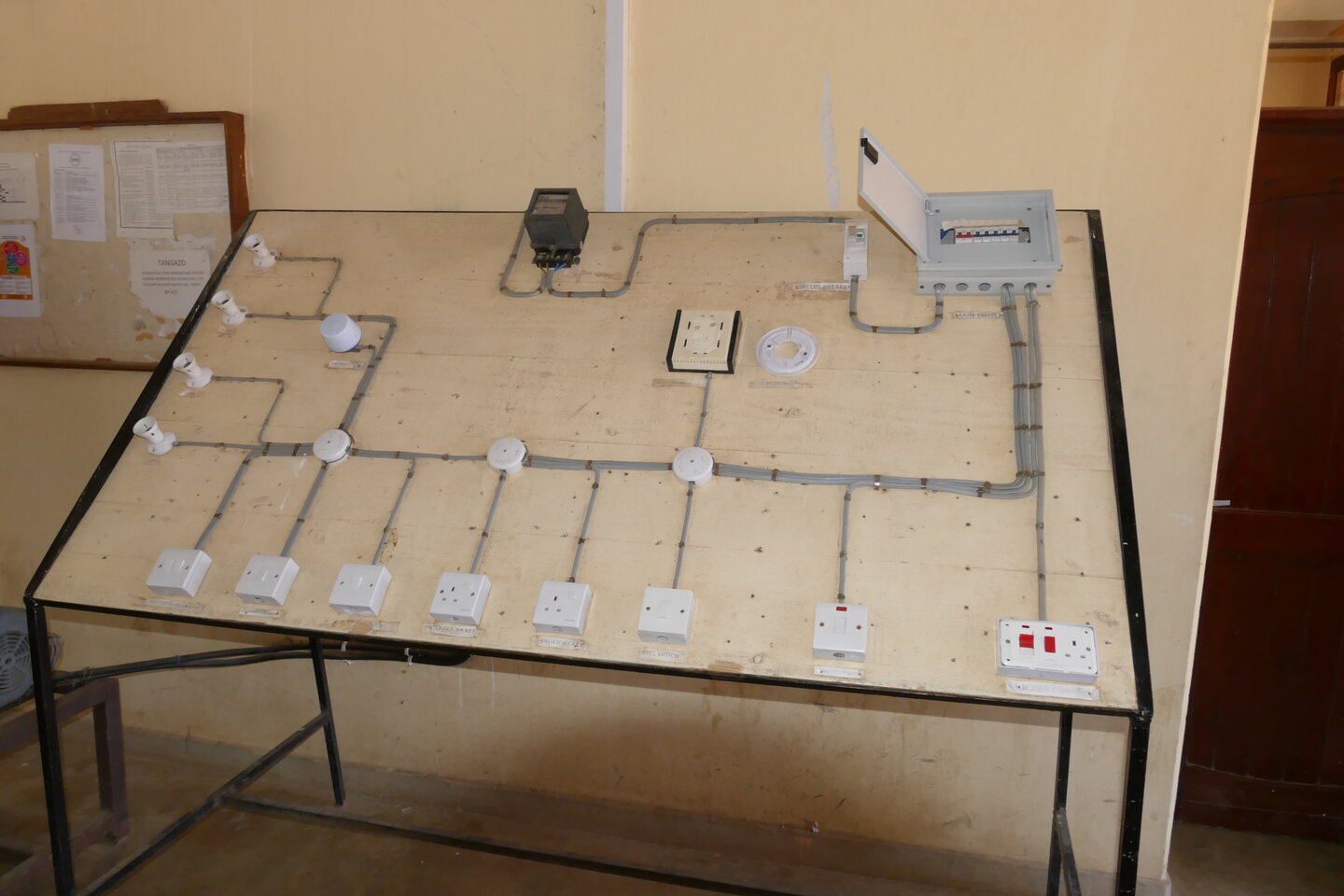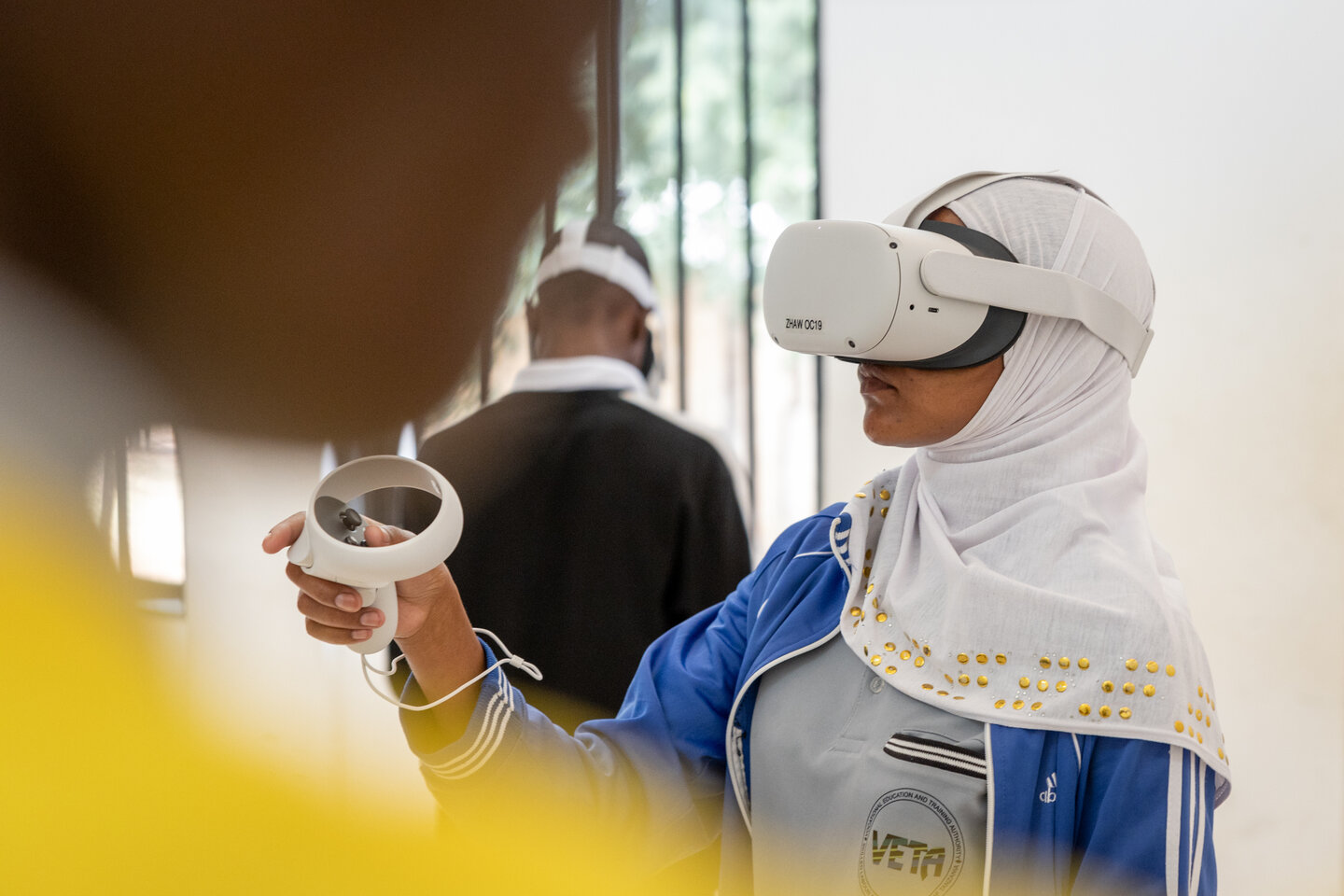Virtual reality (VR) enriches learning and can particularly support vocational training through its immersive action-oriented content. Training in VR boosts student motivation and courses are highly scalable once developed. In central Tanzania, Helvetas and the Zurich University of Applied Sciences (ZHAW) conducted a VR pilot study with electrical engineering students at two government vocational training schools.
Vocational training institutions in low-income countries often face a scarcity of modern, and often expensive, physical teaching equipment. Many students are currently instructed using basic equipment, and then must take short turns to train for practical work. Thus, the tasks in the official training curriculum are often not part of the actual practical training and written tests because there are simply not enough devices and infrastructure to properly train all students. VR can help bridge this gap. A study by the Computers & Education international journal suggests that integrating VR training leads to increased learning successes in primary, secondary and higher education. VR enables students to learn and experiment anytime and anywhere with different challenging or even potentially dangerous practical activities — and requires minimal supervision from an instructor.

Testing with Tanzanian students
In June 2022, Helvetas and the School of Engineering of the Zurich University of Applied Sciences (ZHAW) explored the potential of using VR technology with electrical engineering students in Tanzania’s public technical and vocational education and training (TVET) colleges. Tests were conducted in Dodoma and Singida, two of the 33 nationwide colleges of the Vocational Training and Education Authorities (VETA). Helvetas currently works with VETA on two projects: a vocational skills training project in central Tanzania, and in the gamification and marketing of mobile learning courses for vocational education.
For this pilot test, the project team created six different measurements based on the existing VETA training curriculum for electrical engineering. When students put on the goggles, they find themselves in a virtual car garage and adjoining basement, where they can test a basic electrical installation of a lamp and a fuse box. After a short introduction to the VR goggles and their features, small groups of students and teachers conducted sophisticated electrical measurements in VR, including visual inspection, insulation measurement and residual-current device measurement. They must be able to correctly perform the specified action elements and respond to any faults in the system. Text and audio aids in Swahili guide students through each task. The learners were able to perform the measurements simultaneously but at their own pace, each using a modern testing device that would not have been available in the required quantity at the other VETA colleges.
The survey conducted after the training showed that 24 students and six instructors enjoyed the experience and found it highly motivating. Younger teachers and students appeared to learn the technology quickest, indicating that prior exposure to video and mobile games may help with learning the controls. An additional survey will be performed to learn more about the experiences and challenges students and teachers faced.

Broader VR research project in Switzerland
The pilot test is part of a bigger research project by ZHAW and the Zurich University of Teacher Education (PHZH) that tests the effects of VR training on the final exam grades of Swiss electrical engineering students. The research project is financed by the Digitalization Initiative of the Zurich Higher Education Institutions. The goal is to examine the necessary didactic principles (scaffolding) and design factors (theory inputs and gamification elements) for an effective use of VR for basic vocational education in Switzerland and in Tanzania.
In Switzerland, the team from ZHAW and PHZH tested the VR use case with electrical installation apprentices who are preparing for their first-year exam. In the VR environment, the students must perform challenging safety checks of electrical installations, exactly as specified by the Swiss standardization organization Electrosuisse.
In addition, the research team will work with a Swiss software company to explore a viable business and operating model for the production and distribution of VR learning units in Switzerland.
Next steps for the VR pilot
The Swiss version of the VR scenario has further elements that support the learning process, including a help screen that shows the next work steps and can offer further support if needed. Learners also selectively receive theoretical input via the chat box-like dashboard. A leaderboard serves as a gamification element that helps to boost the motivation of the students. The results of a comprehensive field study with 75 apprentices split in a VR intervention group and a control group in two Swiss cantons are currently being evaluated and will give better insights into the effectiveness of the VR training scenarios.
VR will (for now) not change the way we learn, but well-developed VR training applications can be a valuable addition to learning environments for vocational skills training. The pilots in Switzerland and Tanzania have already shown where we can improve the tests for electrical engineering students, starting with a multi-user feature that allows instructors to have remote access to students' goggles for assistance without having to take off students’ glasses. For the Tanzanian version of the scenarios, a great addition would be more audio for assistance in Swahili.
A growing VR ecosystem in East Africa
While the government agency VETA is only starting to explore VR for vocational training, VR is not completely new to the TVET space in East Africa. The Belgium Development Agency, Enabel, piloted VR technology in 2017 as an IT aid to train hand pump mechanics at refugee camps. Various INGOs are also currently exploring the technology alongside local partners in the region for skills in trainings in welding.
Private virtual reality production companies have also been active for some years now in Tanzania and East Africa. OnaStories in Tanzania combines VR/AR media training to companies and NGOs through VR video production and journalistic storytelling for private and institutional clients. Large local IT companies like Magilatech are also starting to explore the use of VR technology. And the pioneer in the region since 2015 has been Nairobi-based BlackRhino VR, which uses immersive VR technologies to develop educational material and marketing campaigns for large national and international organizations.
The pilot in Tanzania demonstrates the fascination with this technology by teachers and students. There is further exploration to be done on how a meaningful project could be implemented in the development sector. Digital learning in general still has a long way to go in many places, and VR can be one of the key elements of modern online training platforms and systems. Since the use of VR is still limited in Switzerland’s vocational training institutions, valid business cases that involve already existing local VR companies is also a space for opportunity.
About the Authors
Dr. Reto Knaack is a lecturer in Numerical Mathematics and Scientific Computing at ZHAW. Franz Thiel is Helvetas' Advisor for Digital Communications and lives in Tanzania.


